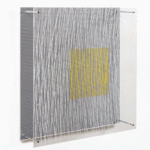(Hungary, 1908–France, 1997), Vásárhelyi Győző, renamed in France as Victor Vasarely, was the father of Op art. At the beginning of the 1930s he settled in Paris, where he worked as a graphic designer for advertising agencies. After a period of figurative expression, he opted for constructive and geometric abstract art. Starting his main artistic research: around geometric abstract art, which provides optical effects of movement. Vasarely called this development visual kinetics (cinétique plastique) and based on the perception of the viewer who, in the end, is considered the sole creator of the work.
From 1948 onwards he regularly exhibited at the Denise René gallery and began to make works of integration with the space. He received the Guggenheim International Prize in 1964 and the Grand Prize of the Sao Paulo Biennial in 1965. In these years he made two-dimensional works that visually suggest movement and three-dimensional works that require the movement of the viewer to produce the kinetic effect. At the end of the sixties he received new recognition for his work, such as the Painting Prize from the Carnegie Institute of Pittsburgh.














